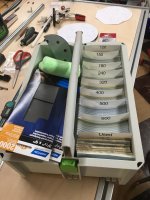smorgasbord
Member
Just watched Sedge's latest:=myZkrgzro3t2XLtY&t=165
He's using the DTS400 although he doesn't have corners to sand (in orbital mode), I suspect because he has lots of edges to do and even the ETS EC125 can be ungainly without an edge guide.
But that's not what I'm talking about.
He's sanding on plywood at 180 grit for his one and final pass. The grit choice is OK since, as he says, a lot of plywood is pre-sanded to 120. But, this is his last pass before finishing. Maybe it's just my old school, but I've always made sure my last sanding pass is linear sanded with the grain. For small-medium projects that's by hand (I use a cork block to which I've attached velcro hooks and I have a Mirka vacuum-compatible hand sander), and for larger projects I use an LS-130.
Do people not do this anymore? My expectation is that a linear sand at any grit produces better results than orbital sanding at that same grit.
Maybe because he's using Rubio it doesn't matter as much? I haven't used Rubio, but the Tung oil finishes (pure and polymerized) and Odies I've used sure seem to elevate any sanding scratches to high visibility.
He's using the DTS400 although he doesn't have corners to sand (in orbital mode), I suspect because he has lots of edges to do and even the ETS EC125 can be ungainly without an edge guide.
But that's not what I'm talking about.
He's sanding on plywood at 180 grit for his one and final pass. The grit choice is OK since, as he says, a lot of plywood is pre-sanded to 120. But, this is his last pass before finishing. Maybe it's just my old school, but I've always made sure my last sanding pass is linear sanded with the grain. For small-medium projects that's by hand (I use a cork block to which I've attached velcro hooks and I have a Mirka vacuum-compatible hand sander), and for larger projects I use an LS-130.
Do people not do this anymore? My expectation is that a linear sand at any grit produces better results than orbital sanding at that same grit.
Maybe because he's using Rubio it doesn't matter as much? I haven't used Rubio, but the Tung oil finishes (pure and polymerized) and Odies I've used sure seem to elevate any sanding scratches to high visibility.

